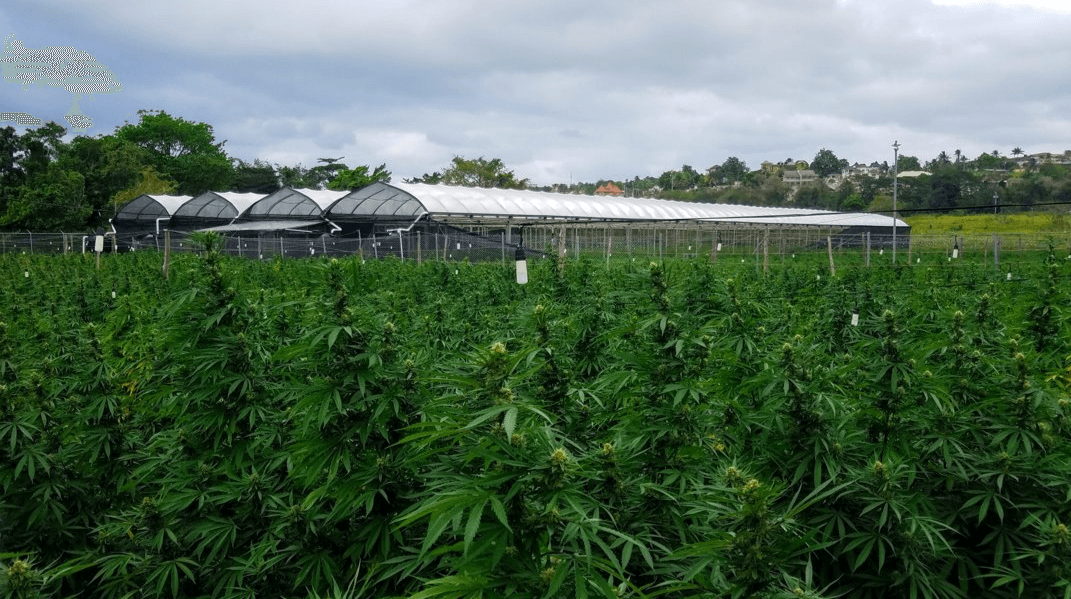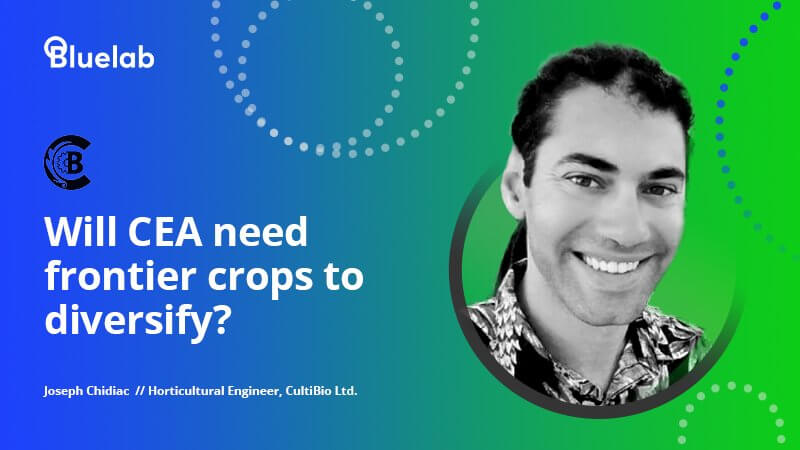Bluelab's Future of Controlled Agriculture webinar series brings the best minds in CEA together to discuss the frontier of horticulture. Our hosts talk with plant scientists, top CEA researchers, and engineers for a unique lens on what we can expect in the future of CEA.
This time, Jon Greene, Senior Technical Specialist here at Bluelab talks with industry thought-leader, Joseph Chidiac (JC), CEO and Horticultural Engineer of CultiBio Ltd on the importance of CEA needing frontier crops to diversify.
JC sheds light on how new crops, like bananas and goji berries, can be grown locally using hydroponics to eliminate food imports and create more sustainable food supply chains. This conversation also takes an in-depth look at how hydroponics, systems innovation and technology create unprecedented opportunities for future global supply chains.
Download the full conversation, otherwise, read on for the key takeaways.
Key takeaways
Firstly, what do we mean by "frontier" crops?
Throughout this webinar, Jon and JC frequently refer to frontier CEA crops by which they mean crops beyond the traditional leafy greens and herbs. Think broccoli, root vegetables, goji berries, wasabi, and even bananas that can now be grown locally using hydroponics thanks to recent technology improvements.
As hydroponics' crop range expands beyond leafy greens and herbs, we have a unique opportunity to reduce food imports and create more sustainable food supply chains.
The opportunity lies in new techniques and crop varieties
Growing crops in the 21st century is a unique challenge, yet an unprecedented opportunity. The combined power of nature and human ingenuity elevates the standard of growing with systems that create efficiencies, productivity and a more sustainable way of growing.
A part of introducing new techniques and frontier crops is breaking out of the traditional foods we commonly grow and eat which come from a centralised location. Taking this approach has lent itself to the decentralisation of some of those crops and has already had a positive effect on the global trade and transport of foods.
-png.png)
“The main effect is that you're reducing food miles. So, you're reducing the need for a lot of this bulk produce to be transported that far, and I think that's very positive.”
— Joseph Chidiac, CEO and Horticultural Engineer, CultiBio Ltd
Naturally, what has dominated the industry is fresh and perishable greens, microgreens and delicate vegetables that hold high nutrition value. These don’t travel well, so they are the first ones that have a high incentive to grow locally and regionally. Beyond these viable crops, JC emphasises that we need to explore further afield to see how CEA looks at frontier crops and diversifying, so we can work to eliminate food imports and create more sustainable food supply chains.
Jon supports this sentiment, and uses the example of how urban farm and restaurant Grow + Gather in Colorado has successfully used CEA to create a thriving business and reduce food miles.
"The owner Jeff Johnston retrofitted an older 1950's auto repair shop into an urban farm and restaurant, complete with gardens, a greenhouse, and a vertical farm. His indoor hydroponic towers represent 1,200 square feet or 111.5 square meters of cultivation space. The towers alone equate to 1.8 or maybe two acres of field farming and eliminate countless food miles."
—Jon Greene, Senior Technical Specialist, Bluelab
Download the full conversation to learn more about how CEA can reduce food miles by decentralisation.
The shift beyond lettuce and herbs is already happening
JC outlines that there is significant progress being made in reducing food miles and highlights some key milestones in CEA.
- More farms are popping up in the US or Canada to reduce the need for transport and reduce greenhouse gases.
- In Holland and Iceland, we are seeing greenhouses growing bananas. Transport costs are cut and there are smart schemes available where people are using cogeneration and taking advantage of steam.
- Europe is growing papayas, spinach and arugula which are typically imported. With movements to CEA in Europe mean crops such as apples, almonds, cherries (which are susceptible to diseases that require a lot of pesticides and fungicides) will have those inputs eliminated.
- The Caribbean is growing cilantro and cold-weather crops.
- China has more traditional orchards transitioning to CEA.
- As root crops increase in price, it is going to be a viable option to produce these vegetables locally. Broccoli and cabbage grow really well in hydroponics. Although they take up space, it will inevitably get to the point where this is a more viable option that will outweigh the space and effort involved versus transporting these crops.
To improve diversification, different hydroponic methods are worth exploration
There are multiple hydroponic methods available, with each one suiting certain crop groups better than others. JC and the team at CultiBio are continuing to explore and develop hybrid methods—mainly NFT (Nutrient Film Technique) and DFT (Deep Flow Technique). Getting more growers to share information about different techniques ensures success the first time.
Ebb and flow benching is a method easily adapted to a hydroponic system. It is very common in the nursery industry and plant production as you can maximize space efficiency in the greenhouse.
Ultimately, JC wants to ensure all methods of hydroponics tick the boxes of being adaptable, versatile, effective, efficient and ergonomic.

Flood and drain system, allowing leafy greens—which are traditionally imported from Europe—to be grown in tropical climates
Fogponics is another fascinating frontier the industry will see more of in future. This method involves pumping air or water vapour (instead of water) through the system. Less energy is required and as it’s clearly maximally aerated, there’s no worry about dissolved oxygen.
JC says that the more types of hydroponics we try, the better.
“The end game is to saturate the demand for these things and show they don’t need to be imported, show that the quality and shelf life is actually better when they’re not imported to match the price”
—Joseph Chidiac
There are still challenges to diversity with CEA and frontier crops
In the webinar, JC and Jon reinforce the exciting opportunities of CEA, however also outline a few challenges.
- Lack of awareness and education. There are growers who believe hydroponics are not natural and fear the unknown.
- Economics. Ensuring there is a market that will accept your prices and your quantities. Farmers heavily focus on the bottom line.
- Resistance and unbacked claims. Many people have formed an opinion on CEA without the chance to experience it first-hand, or speak to farmers directly.
- Misinformed growers. Information received from unqualified sources online and the belief there are a lack of options.
Why hydroponics, and not soil?
JC reinforces that soil is life-sustaining; however, it does pose a lot of risks because it is unpredictable and inconsistent. There are a lot of pathogens and close management of nutrients is required to ensure plant diseases are kept at bay with fungicides and herbicides.
This traditional method is also not the most efficient use of water and fertilisers unless growers invest in building healthy organic soil, which isn’t what most large farmers do. However, with close management of soil fertility, adjustment of texture and ensuring it’s inoculated with good microbes - will lead to excellent results.
In certain parts of the world, however, soil isn’t practical. This is where there’s a huge opportunity for hydroponics as a root management solution.
“If you don’t provide it, [nutrients] it isn’t there. Because in nature, you have so many insects, worms and microbes doing things for you that you can ignore and not even know about, and be proud of yourself because you grew a tomato. But in hydroponics, if you didn’t make it happen, it’s not there.”
—Joseph Chidiac
The role of EC and pH
No matter how good the fertiliser is, if you don’t regulate your pH or stay aware of your EC ranges, it will cause damage to your plants—leading growers to restart the entire process.
Hydroponic, water-soluble, mineral-based fertilisers are unsustainable, yet effective and efficient. You also don’t want to put organic materials into your nutrient solution in a hydroponic system, as this poses the risk of particulates clogging certain parts of the irrigation systems. For these reasons, CultBio is now looking at alternative solutions.
Caribbean projects are leading the way in diversity and localising food supply
The Caribbean import almost everything, so CEA is a perfect fit to reduce the reliance on imported crops.

Greenhouse in Barbados. Built by Sprung Structures in Alberta and designed to withstand hurricanes with 320 kph (200 mph) winds
Before these projects took place, JC visited Aruba and looked at local farms where there were at least four other hydroponic farms growing the same crops. All farms were interviewed to find out what the key challenges were and ensure there was a strategy to mitigate these with a customised approach. As a result, JC says that this has relieved foreign exchange pressure and boosted the economy.
Another highlight worth mentioning in relation to the Caribbean is the legalisation of licensed cannabis in Jamaica. The climate in the Caribbean to produce licensed cannabis is—perhaps contrary to expectations— extremely harsh. There’s excessive light, wind, water, all the pests and diseases imagined, including pests like monkeys, rabbits and rats.

The climate in the Caribbean is challenging for the plant, but using commercially licensed facilities and CEA has allowed growers to help plants reach their full genetic potential
However, this is what makes Jamaican licensed cannabis so ideal. The harsh climate creates conditions that encourage champion genetics that can handle threats. Therefore, growing the plant in a controlled environment means they perform even better and produce incredible crop results.
“I got to experience firsthand how taking those genetics and growing them in a controlled environment with less stress is incredible. They perform like nobody’s business, to the point where you get results that these farmers and these breeders haven't even seen firsthand.”
—Joseph Chidiac
In conclusion, JC and Jon reinforce that the introduction of new techniques, new crop varieties, engineering innovations and system design creates unprecedented opportunities for future food supply.
The conversation between Jon and JC highlights that new cultivation approaches should be explored with farms and facilities worldwide using hydroponics and soil-less growing. In doing so, we can perfect crop performance and elevate the standard of growing to drive more efficiencies in production, and therefore, profitability.
Download the full webinar on-demand by clicking the image below.



%20(1).png?height=100&name=Blog%20Author%20Bio%20Image%20500x500%20(2)%20(1).png)

Submit a comment